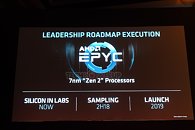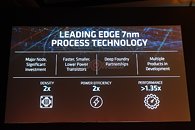Wednesday, June 6th 2018

AMD to Polevault Zen+, Head Straight to 7nm Zen2 for EPYC
AMD in its Computex 2018 address earlier today, mention that its second-generation EPYC enterprise processors will be based on its 7 nanometer "Zen 2" architecture, and not 12 nm "Zen+." The company has the 7 nm silicon ready in its labs, and will begin sampling within the second half of 2018. The first products could launch in 2019, after validations. Besides improved energy-efficiency, the 12 nm "Zen+" architecture features a minor 3-5 percent IPC uplift thanks to improved multi-core clock-speed boosting, and faster caches. "Zen 2," on the other hand, presents AMD with the opportunity to make major design changes to its silicon to achieve higher IPC uplifts. The 7 nm process introduces significant transistor density uplifts over the current process. AMD is in the process of building 4-die multi-chip modules using the 12 nm "Pinnacle Ridge" silicon for its 2nd generation Ryzen Threadripper HEDT client processor family.



33 Comments on AMD to Polevault Zen+, Head Straight to 7nm Zen2 for EPYC
35% faster and 2 times more power efficient means their entire lineup becomes hugely inferior to AMD's offerings even if AMD doesn't break the 4.3GHz barrier.
And given the 8121U fiasco (a 10nm CPU without iGPU with the same power envelope), they are truly f*cked. What a time to be alive: Intel is unable to compete both on tech process and IPC. Last time and perhaps the only time it was AMD K8 over 10 years ago.
Not sure why you say "minor" as it's never called that when Intel releases a new chip, and that seems to be their average increase in IPC.
Whether this was common knowledge or not, it's confirmed now.
Imho, with Zen AMD played their cards right, so instead of looking to fault them, I'm hoping they'll keep it up.
Only Performance by clocks or cores.
We got faster PCIe lanes, faster USB ports, better IGPs, more specialized instructions, better power saving. But performance basically hasn't budged in a decade. On the other hand, this also speaks about Zen's IPC: as miraculous as it is portrayed, it only managed to get AMD to where Intel was a decade ago and still is today.
It isn't 2021 yet, there's still time to improve before Sandy-Bridge turns ten. :)
Small clock increases just don't fly in the enterprise space. Unlike home users, no enterprise user would have been interested in a small 100-200MHz clock increase. Just look at Intel and Xeons: even when they gave us small refreshes, in the enterprise space they almost always had to come up with additional cores, additional sockets support or at least lower TDP.
So this is not a smart move from AMD that no one saw coming, it's just how the enterprise market works.
This news actually has me reconsidering of waiting for Zen on 7nm. I think the wait would be worth it.